Exemplar Audio Portal Cables
|
Exemplar Audio Portal Cables |
|
3D Sound You can Hear! |
|
|
|
April 2011 |
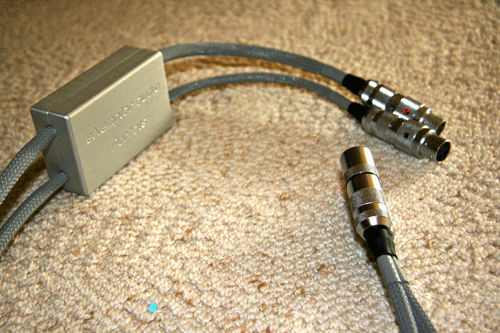
Some say that cables must sound the same if their resistance, impedance, and current carrying abilities are the same. A long time ago I was in a conversation with a famous amplifier designer who actually said, “Electrons don’t know what wire they went through.” This may be true, but In my personal experience, especially in the last ten or fifteen years, I have found that while many average cables do sound alike, there are some similarly made cables that sound exceptional. The cables which are the subject of this review, the Portal cables from Exemplar Audio, are a classic example of this.
First, I’d like to share some technical information on the Portal cables. I had received their interconnects, power cords, and speaker wires for evaluation. The Portals are only line that Exemplar makes. They are charged with 12 volts from a central charger box feeding a small box on the cables. In the case of the interconnects, this box spans between them at the source end of the cables. Initially, I had individual wall warts for each. The charger box is an option for a full complement of cables. It greatly decreases the number of ac outlets you need. I used one. Balanced interconnects are available, but here I used only single-ended (RCA) interconnects. The power cords and speaker wires are available in eleven gauge (high current) as well as the normal 14 gauge versions. The wire used in all cables is 5 nines pure copper. The interconnects use long linear crystal copper. The manufacturer said that long linear crystal copper had been tried for both the speaker wires and the power cords but had not improved the sound despite the greater cost for such wire.
This is what the manufacturer says about these cables:
“Most cables limit the flow of an audio signal in some form or fashion. Our Portals reveal the audio signal to provide unequaled transmission of a pristine audio signal through your system. They not only shield the signal from the ever increasing noise in our environment, utilizing our ‘Cleanfield Technology’ they also provide an environment that enhances signal flow to protect all characteristics of the entire signal. This new form of charging technology shields the signal over a much wider bandwidth than other cables and to a greater degree. We combine our “Cleanfield Technology” with the best sounding wire and connectors we’ve found after many years of research. This results in a musical presentation that provides an unprecedented level of detail and also conveys the emotion of the original performance at a subliminal level.”
There is an additional comment on the Exemplar webpage that I find refreshing: “What I mean (by magic) is that something greater than what I planned is taking place, and I cannot explain it 100 percent. … The most that I need to explain is that a low current voltage is applied to a circuit board through which your signal from a source enters and then exits via our proprietary cables. We call this ‘active affection,’ which means something happens inside the ‘box’ and although I know what’s happening inside the box, I cannot claim to know ALL that happens, because, like I said, it far exceeded my expectations.” I have never before read such candor.
I used four primary recordings during my listening sessions: Holly Cole’s, It Happened One Night [Metro Blue CDP 7243 8 52699 0 5];Frank Sinatra with Count Basie, Sinatra At The Sands [Universal UICY 94366 Japan SHM]; Willie Nelson and Wynton Marsalis Two Men With The Blues [Blue Note Records TOCP-70541 Japan]; and This Is K2 HD Sound! UD [FIM K2 HD 078].
The Holly Cole recording was an outdoor performance where Cole’s voice was great and the soundstage was well defined. Sinatra and the Basie orchestra were in fine fiddle the night of this performance and were captured very accurately on this Blu-ray disc. The Nelson and Marsalis recording has many solo performances with the instruments very well recorded and quite dynamic. Finally, the FIM Ultimate Disc has varied cuts that allow evaluations of percussion (chiefly Christopher Hardy’s “Touch” and Pachelbel’s “Canon in D”), symphonic works (Ansermet’s “Swan Lake Duo” and Habanera’s “Fantasia from Carmen”) and vocals (Esther’s “Kinderpiele” and Nah Youn Sun’s “Heart of Glass”).
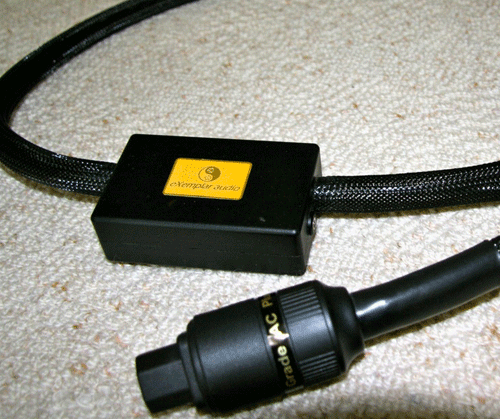
I first received two pairs of the Portal interconnects last summer and used them between source and linestage, and between linestage and amplifier. They took a long time to sound their best. I thought they were good, maybe even very good. Later, at the Rocky Mountain Audio Fest, I got one AC power cord and additional interconnects. I found the power cord had a greater impact on my sound than had the initial interconnects. Finally, Exemplar got their act together in manufacturing these cables, and I received enough power cords to outfit my entire system. There was a marked improvement. The final addition was the Portal speaker wires. They provided the greatest improvement in the overall sound of my system, but of course, as is often the case, the synergy of having all one manufacturer’s cables, yields a whole that is greater than the parts. The speaker wires took several weeks to be at their best. Every several days I would hear a clearly audible improvement and concluded that they were finally at their best, only to conclude later that they were not.
Now, I even have Portal interconnects running to my subwoofer and a Portal power cord on its built-in amplifier. I made no attempt to assess the relative contributions of interconnects, power cords, or speaker wires by removing all of one or the other, but I think the speaker wires are essential.
It was the Holly Cole disc where I heard the first impact of the Portals. This recording was playing before I inserted the Portal power cords to the H-Cat P-12R line stage and the H-Cat DF-100.2 amplifier. The Portal interconnects and power cord were already on the Weiss DAC202. I was immediately struck by the involvement I felt in the soundstage. I realized that my earlier modest impression of these cables was wrong. They were excellent. I should say that this judgment was also premature. Two weeks later, with the inclusion of the speaker wires, and with all Exemplar Portal cabling throughout my system, and more break-in on them, I heard a thrilling realism, especially for live recordings. The resolution of detail, often not musical detail, such as musicians moving around or getting prepared to join in the music making, was striking suggesting a very low noise floor.
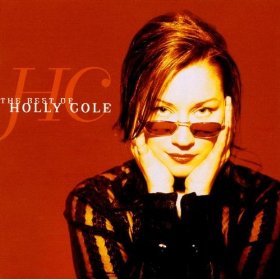 Track six of the Cole disc, “Don’t Let the Tear Drops Rust Your Shinning Heart” best illustrates the realism you get. You hear the full breath of the stage where she is and the location of the musicians on it and the audience before them. In fact, I had difficulty grasping a major contradiction in recording a live performance. She is facing the audience and singing into the microphone but you are looking out onto the audience before you. So you should be hearing her singing from behind or beside her, not facing you. I had not faced this quandary before.
Track six of the Cole disc, “Don’t Let the Tear Drops Rust Your Shinning Heart” best illustrates the realism you get. You hear the full breath of the stage where she is and the location of the musicians on it and the audience before them. In fact, I had difficulty grasping a major contradiction in recording a live performance. She is facing the audience and singing into the microphone but you are looking out onto the audience before you. So you should be hearing her singing from behind or beside her, not facing you. I had not faced this quandary before.
Studio recordings do not put you into this position; you are in front of the musicians listening. The FIM disc, This is K2 HD Sound!provides many studio examples. 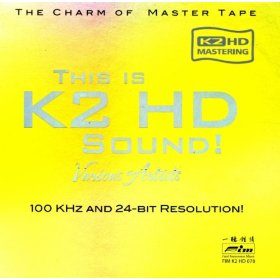 I typically focus on several. Track five, Christopher Hardy’s, “Touch,” gives a series of chimes and gongs along with a Congo drum. You are in the recording studio and before the musicians. You know precisely where the drum is and can feel its impact and the decay of the strikes or double strike on the gongs. But it is track seven, Ansermet’s “Swan Lake Duo,” which is just awesome in its realism. Your perspective is clearly being in the audience, but in the best possible seat, centered and about ten feet above the audience. I was so moved by this recording that I sought the entire performance. I have not found it yet. The violin and cello as well as the plucked basses are so real. I have been to many live performances that we nowhere near as thrilling as what I hear in my room on this recording.
I typically focus on several. Track five, Christopher Hardy’s, “Touch,” gives a series of chimes and gongs along with a Congo drum. You are in the recording studio and before the musicians. You know precisely where the drum is and can feel its impact and the decay of the strikes or double strike on the gongs. But it is track seven, Ansermet’s “Swan Lake Duo,” which is just awesome in its realism. Your perspective is clearly being in the audience, but in the best possible seat, centered and about ten feet above the audience. I was so moved by this recording that I sought the entire performance. I have not found it yet. The violin and cello as well as the plucked basses are so real. I have been to many live performances that we nowhere near as thrilling as what I hear in my room on this recording.
Finally, I should comment on track sixteen, Pachelbel’s “Canon in D,” recorded by Harold Farberman’s all-star percussion ensemble. Of course, this track is full of percussions ranging from bells to gongs and big drums, but there are also many extraneous noises, such as something large on the left side being rolled into position, musicians moving about, and a truck driving away. One can get tired of this pretty quickly, but it is an excellent recording for equipment and cable evaluation. When struck, the wood and metal sound very real and startling.
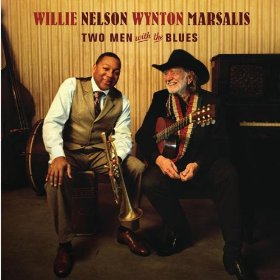 If everything is right, the Willie Nelson and Wynton Marsalis recording can sound very real with the band and audience being quite present. Most of the tracks highlight Nelson and Marsalis, but the drummer, harmonica player, pianist, and other musicians are rendered with excellent clarity. Marsalis’ brass is quite ripe and real. The drums are well defined and have real impact, and Willie is quite nasal and right in character with the music. The musicians and audience are obviously greatly enjoying themselves and so was I.
If everything is right, the Willie Nelson and Wynton Marsalis recording can sound very real with the band and audience being quite present. Most of the tracks highlight Nelson and Marsalis, but the drummer, harmonica player, pianist, and other musicians are rendered with excellent clarity. Marsalis’ brass is quite ripe and real. The drums are well defined and have real impact, and Willie is quite nasal and right in character with the music. The musicians and audience are obviously greatly enjoying themselves and so was I.
The Frank Sinatra and Count Basie recording was one of Sinatra’s best and my “Super High Materials” (SHM) copy is the best digital version I have heard. What is different with it is the large band working with Sinatra and the large room at the Sands. My two favorite cuts are track two, “I Got a Crush on You” and track six, “One for my Baby.” Both cuts emphasize Sinatra, but the band is somewhat more active on the first of these cuts. Basie’s piano and a trumpeter, with whom Sinatra interacts spontaneously, have real presence. The band’s coming in on occasion enriches ones sense of being there. The second cut is more intimate with Sinatra fumbling with the mic at the beginning and typical Basie piano playing. Again with these cables, it is the total plausibility of being there that most thrills me.
My overall conclusion about the Exemplar Portals is that the total system is a must to hear what they do. And what they do is to give you an ease to the music with great detail, substantial dynamics and clarity, great bass, and the greatest realism I have ever heard. What comes to mind is the difference between a 3D movie and a normal movie. The latter gives you an impression of depth as some things are further back, but with a 3D movie, things have a roundness or perspective. The Exemplar Portals are 3D cables. Never before have I had such a sense of being in the studio or at the recording event. While these cables are not cheap, nor are they the most expensive cables you could buy. Are they the best in the world? I cannot say that given the virtually infinite number of cables available. I certainly am greatly impressed with what I hear.
Additional Thoughts on the Exemplar Portal Silver Interconnects as of December, 2011.
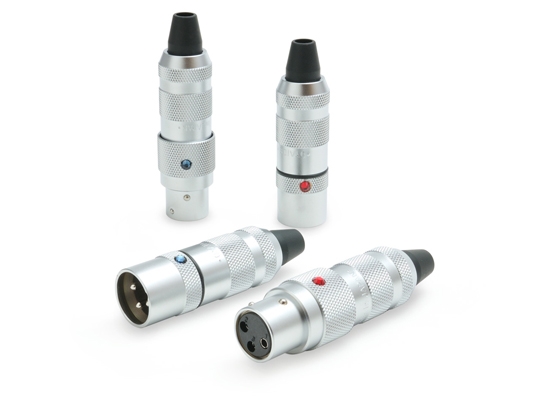
It is awkward for a reviewer when he has to say that another cable is better than one that he previously gave a rave review to. That is, however, the truth. I said that the Exemplar charged, long linear crystal copper Portals (originally reviewed back in April of 2011) were clearly extraordinarily good interconnects, but since that time, I have experienced Exemplar Audio’s new charged, long linear crystal silver Portals both single-ended and balanced. The wire in these cables is a very expensive long linear crystal and plugs are Oyaide Focus 1 connectors with 4 9s silver pins (photo above). There is nothing more to say but wow!
I am now using BMC electronics, which allow both single-ended (RCA) and balanced (XLR) cable use. I introduced the three sets of cables one at a time. The first was a special cable with RCA plugs at the turntable end and XLRs at the phono stage end. I had been using a similar Portal copper cable there. I must say I was shocked on the first several notes as the music was totally involving. Next we compared the copper balanced Portals and the single-ended Silver Portals with the balanced Silver Portals from the phono stage to the line stage. I did not expect the great improvement that I heard with switch to the balanced silver versions.
With the link between the preamp and amps clearly optimized for balanced configuration, I expected it would have the maximum impact going from copper to silver balanced cabling. This is exactly what we heard. Clearly, the final link made the maximum difference, but each link was a revelation. I should also say that I “cooked” each pair of the balanced Silver Portals for 24 hours. Nevertheless, each day since installation has seen a great improvement. This is not surprising as the Exemplar coppers and the silver single-ended cables continued to improve for about a week.
Initially, I heard striking realism of singer’s mouths and breathing as well a musical instrument noises. Yes, I know this is not the essence of the music, but it is of realism. Also the supportive players in the recordings seemed highlighted by these cables. Often I had not previously been much aware of them. This is much more evident with the balanced cables as they are quieter. Later this illumination of side players grew to being an illumination of the entire stage, including the audience. Everything became palpable. The soundstage of the recording venue was laid out clearly in front of me. I continually heard the decay of the voice or instruments in the recording studio or arena. Another property has been a sense of roundness of singers and of instruments on center stage. They are in 3D to use a visual analogy. Again the realism was just thrilling. Joni Mitchell’s Miles of Aisles [Elektra] was like being in the best seat rather than at the outer edge as I actually had.
I will go no further, but I strongly urge you to give a listen to these admittedly expensive cables. There certainly are even more expensive cables that cannot compete with them, however. They have given me perhaps the greatest improvement in music reproduction I have had.
![]()
![]()
Exemplar Audio Portal cables
Single ended interconnects: 1m RCA $2800, 1m XLR $3200
Power cord: 1.5m $1400, 1.5m high current $1800
Speaker wires : 2m spades $2800, 2m high current $3200
Exemplar Audio
2909 95th Drive SE
Lake Stevens, WA 98258
Phone: (425) 334-4733
Website: http://exemplaraudio.com/Home.html
![]()
Don’t forget to bookmark us! (CTRL-SHFT-D)
Stereo Times Masthead
Publisher/Founder
Clement Perry
Editor
Dave Thomas
Senior Editors
Frank Alles, Mike Girardi, Russell Lichter, Terry London, Moreno Mitchell, Paul Szabady, Bill Wells, Mike Wright, and Stephen Yan,
Current Contributors
David Abramson, Tim Barrall, Dave Allison, Ron Cook, Lewis Dardick, John Hoffman, Dan Secula, Don Shaulis, Greg Simmons, Eric Teh, Greg Voth, Richard Willie, Ed Van Winkle, Rob Dockery, Richard Doron, and Daveed Turek
Site Management Clement Perry
Ad Designer: Martin Perry





Be the first to comment on: Exemplar Audio Portal Cables